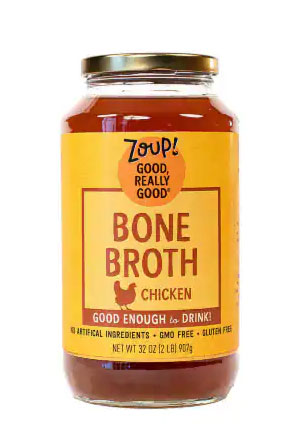As health-conscious consumers increasingly demonstrate a desire for more nutrient-dense foods in their everyday diets, bone broth remains a popular way to soak in additional vitamins and minerals. The boldness of bone broth can enhance the flavor profile of everything from soups to plain white rice, and offers a depth of flavor often lacking in the average broth, says Lauren Manaker, a registered dietician based in Charleston, South Carolina.
Plus, it’s pretty easy to like: “If something doesn’t taste good, why even bother?” she says. “Bone broth has more of a meaty taste, richer than a broth. It’s nice just to sip on, unlike watery broth.”
As temperatures drop, few things are as comforting as sipping on soup, and when it comes to nutrition, bone broth packs a major punch—up to 10 grams per 8-ounce serving.
Bone broth, better known as stock, is made by cooking animal bones, cartilage and connective tissues in water for up to 48 hours. It is prized for being high in protein and amino acids from collagen, and believed to support kidney, joint and digestive health. Though scientific studies are lacking, bone broth’s origins date back thousands of years, and it remains a staple of Asian diets.
“There isn’t a ton of data studying bone broth specifically, but there is data on the features of bone broth,” Manaker says. “People are focused on gut and skin health these days, adding collagen to everything and taking a more proactive approach. Including something like bone broth has very little downside.”
Consumers don’t seem to mind that more research is still needed on some of bone broth’s claims: According to Persistent Market Research, sales of bone broth are projected to reach $112 million annually by the end of the decade. Although several store-bought varieties are available, bone broth can also be made at home. “Making one is as easy as getting your hands on fresh, meaty bones,” the New York Times reported in 2015 in an article about the overlap of bone broth and the Paleo diet—“preferably including some knuckles or necks or another cartilaginous part—then covering them with water and simmering them patiently until the broth tastes good to you.”
Although the base for most bone broths is beef, chicken (or sometimes fish), there are now also unique flavors like Thai, tomato beef and mocha. Many bone broths come in glass jars, while other brands have bone broth stick packs, made by mixing the packet in 8 to 10 ounces of water. Further, bone broth is also a reliable 1-to-1 substitute in recipes that call for water: At home, Manaker uses bone broth to increase the protein intake of her 6-year-old, making rice with bone broth instead of water.
“Anywhere you use broth or water, you can swap out for bone broth,” Manaker says. “It’s more of a noticeable flavor — heartier without feeling super heavy.” Some brands to try include: Zoup, Lonolife, Pacific, Simple Truth, Kettle & Fire, Imagine, Bare Bones and Broth by Design.
Brands to try and shop at Kroger:
|
|
|



 Simple Truth Organic Chicken Bone Broth
Simple Truth Organic Chicken Bone Broth